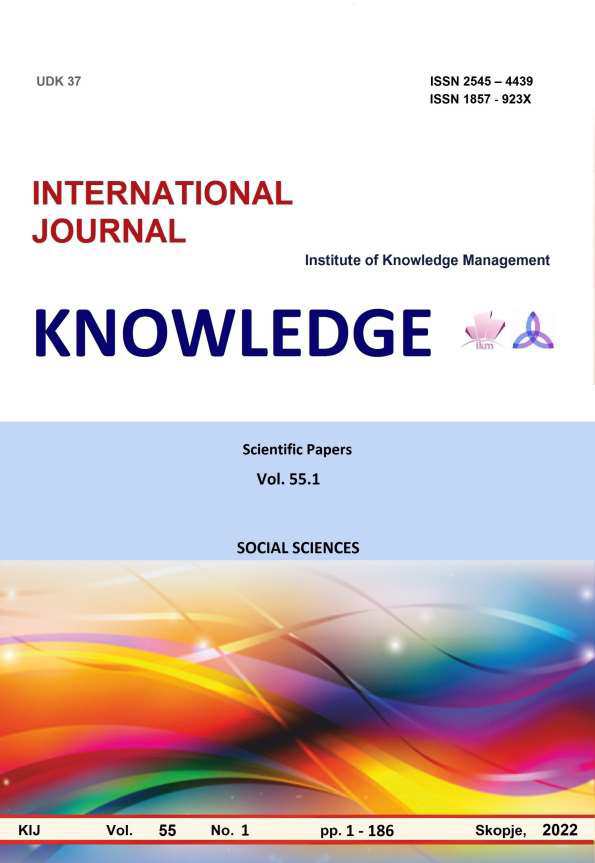FLUID PRODUCT – ADOPTIVE PRODUCT ACROSS DIFFERENT USERS AND SCENARIOS
Keywords:
Fluid products, collective intelligence, reduction, reusableAbstract
Fluid products or “One-fits-All” trend is about ignoring social constructs and not allowing society to limit
us by pushing their stereotypes on us. We like cloths that don`t need ironing, easy to wash and dry fast. It`s a start of
a new era of a care-free lifestyle. New times require generic, easy to use and adjustable products: resizing, multifunctional,
portable, unisex, color changing, gender fluid, reusable, products with sharing capabilities. The gap
between different age groups and life stages is reduced, with adults and children alike consuming the same
entertainment, participating in the same leisure activities and buying the same fashion items. Flexibility is the name
of the game. With a growing remote workforce, consumers’ daily lives are fluid and brands must adapt to lifestyles
no longer defined by 9-5 work cultures.” The Aim of this Academic Research is to show the correlation between
user’s lifestyle and how they experience fluid products. As a result, companies can design more fluid products and
society can transform into sharing economy. In the initial phases of the research, was taken assistance of: Black
Tech companies, New Retail Businesses and Trend Research Agencies to participate in formulating solid
environment, recourses and parameters for the research planning part. 150 volunteers at the age between 25 and 75,
before filtering and 50 volunteers after the second-round filtration actively participated in getting consensus on their
perception of Fluid Products, and what triggers changes on their behavior, regarding the product adoptability. The
research period was operating in the last year and their consumption status has been tracked within this period. Open
Ended Questions were used to define repeating patterns of maximum likelihood. In order to deepen the analysis,
Mixed method of empirical and qualitative analysis was used to formulate questionnaires and increase the level of
accuracy. Experienced Psychologists and Product Designers were selected as a dimension to estimate the result. This
study is also the first, as known by the authors, to examine the direct effect of fluidity of the products on the
perceived value of the purchase.
References
Alwx, P., Alexander, L., & Thomas, H. (2021). Building the new economy, ISBN 9780262543156. Retrieved from https://mitpress.mit.edu/9780262543156/building-the-new-economy/
Cacioppo, J., Louise C.H., Greg J. N., & Gary G. B.(2011). Social iso¬la¬¬¬tion. Center for Cognitive and Social Neuroscience, University of Chicago, Illinois, ISSN 0077-8923, (pp.1-6). Retrieved from https://static1.squarespace.com/static/531897cde4b0fa5080a9b19e/t/533d7dcce4b0b959d0ea74fc/1396538828105/social-isolation-2011.pdf
Cleveland, C.J., & Ruth, M. (1998). Indicators of dematerialization and the materials intensity of use. Journal of industrial ecology, 2(3), pp.15-50.
Corner, M. (2002). Religion and the rise of advertising. The Guardian Labs, Retrieved from https://www.theguardian.com/media/2002/mar/02/raceandreligion.religion
Erica, H. (2019). Just enough research.Publisher: Jeffrey Zeldman. Retrieved from https://dokumen.pub/just-enough-research-9-9781937557898.html
Friedman, W., Michael K., Edward, M., & Rebecca, T. (2011). Education as Liberation?. National Bureau of Economic Research 1050, Cambridge, (pp.20-35). Retrieved from https://www.nber.org/system/files/working_papers/w16939/w16939.pdf
Fry, R. (2016). Millennials overtake Baby Boomers as America’s largest generation’, Pew Research Center. (pp.10-36) Retrieved from https://www.bcit.cc/cms/lib/NJ03000372/Centricity/Domain/701/Millennials%20overtake%20Baby%20Boomers%20as%20Americas%20largest%20generation%20Pew%20Research%20Center.pdf
Giesecke, M. (2018). The Social Credit System in China - Leadership in the Digital Age. GRIN Verlag. ISBN – 13 978-3668804456. Retrieved from https://www.amazon.com/Social-Credit-System-Leadership-Digital/dp/3668804451/ref=monarch_sidesheet
Glynis, M.B., Daniel, M.W., & Julie, B. (2020). Research Methods in Psychology. 5th edition. Sage. Los Angeles. Retrieved from https://researchportal.bath.ac.uk/en/publications/research-methods-in-psychology-3
Hildebjorg. Karlsen Bjorge, Hapti-Co. (2015), "Haptic Communication: The American Edition of the Original Title Haptisk Kommunikasjon", Helen Keller National Center
Joseph, H., Steven, J., & Ana, N. (2010). The Weirdest People in the World?. Behavioral and Brain, Publisher: Cambridge University Press, pp. 61-83. Retrieved from https://www.cambridge.org/core/journals/behavioral-and-brain-sciences/article/abs/weirdest-people-in-the-world/BF84F7517D56AFF7B7EB58411A554C17
Lauren, I. L., Ereni, M., & George, R.M. (2011). Online Personal Branding: Processes. Journal of Interactive Marketing. Challenges, and Implications,Vernon Press, pp. 37-50. Retrieved from https://ar.booksc.org/book/13518357/6598ea
Lee, Y., & Circella, G. (2019). ICT, millennials' lifestyles, and travel choices. In “Advances in transport policy and planning”, Academic Press
Leibowitz A., & Tollison, R. (1980). “Majority is provided 65 percent assurance of passage”, The Quarterly Journal of Economics, 1980 www. academic.oup.com
Milinski, M. (2016). Reputation, a universal currency for human social interactions. Royal Society. Retrieved from https://royalsocietypublishing.org/doi/10.1098/rstb.2015.0100
Miller, S.A. (2020). Five misperceptions surrounding the environmental impacts of single-use plastic. Environmental Science & Technology, 54(22), pp.14143-14151. Retrieved from https://pubs.acs.org/doi/abs/10.1021/acs.est.0c05295
Mintels, T. (2018). Consumer Trends 2018” Report, Global Market Research & Market Insight. China and North China. Retrieved from https://www.mintel.com/european-consumer-trends
Nassim Nicholas Taleb (2010). “The Black Swan, the impact of highly improbable”, Random House Trade Paperback Edition
Niklas, A. (2019). Building a Cashless Society:The Swedish Route to the Future of Cash Payments. Ch.1. Money:The Greatest Innov. in the Hystory of Humanity. Publisher Springer Cham. Retrieved from https://link.springer.com/book/10.1007/978-3-030-10689-8
Pengjun, Z., & Di, L. (2022). Links Between Lifestyle and Transport. Part of the Population, Regional Development and Transport book series (PRDT). Pp.59-96. Retrieved from https://link.springer.com/chapter/10.1007/978-981-19-4399-7_3
Pentland, A., Alexander, L., & Thomas, H. (2021). Building the New Economy: Data as Capital., Massachisets Institute of Technology MIT Press. Retrieved from https://www.media.mit.edu/publications/building-the-new-economy/
Shermer, M. (2021). The reality distortion field: Steve Jobs's modus operandi of ignoring reality is a double-edged sword. Skeptic/ Altadena, CA, vol.17. no.4, pp.29
Straus, R.A. (2000). Strategic Self-hypnosis: How to Overcome Stress, Improve Performance, and Live to Your Fullest Potential. iUniverse.
Trendhunter Trends, Innovation and Trend Spotting community, (2021). Trend Report 2021. Retrieved from https://creative-trends-services.myshopify.com/
Wolpert, D.H., & Tumer, K. (1999). An introduction to collective intelligence. Tech Report: NASA-ARC-IC-99-63 pp.1-88. Retrieved from https://arxiv.org/pdf/cs/9908014.pdf





